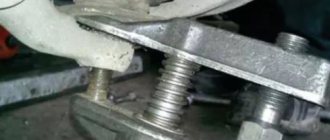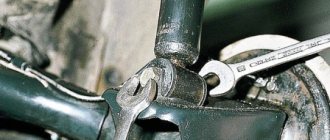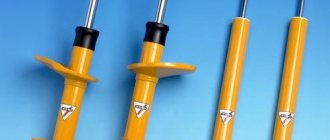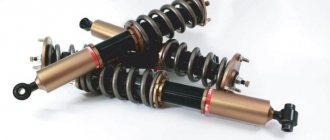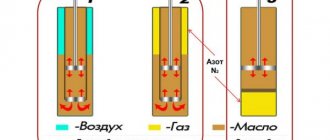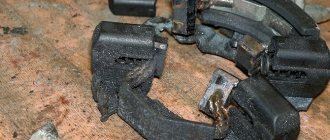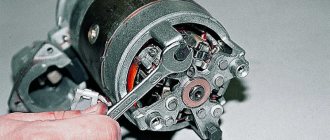Quite often you can hear the question: how to change shock absorbers, because there are many people who want to repair the suspension themselves, both among experienced car owners and among novice motorists. But contrary to popular belief, it is not difficult and not difficult. The answer to the question will vary slightly depending on the car model and whether the shock absorbers are front or rear. But if you replaced the front strut of the car with your own hands, then you will not have any questions when replacing the rear one.
Tool kit for replacing shock absorbers
For DIY repairs you must have:
Wrenches included. It has a special design designed to facilitate the work process in a small, confined work space.
The tool consists of a handle as a single unit and a working part, which has a special design. Keys included:
- Carobaceae. Used for screwing fasteners that have a hexagonal shape;
- Caps. Work with cap devices;
- Combined. On one side there is an open-end wrench, and on the other a spanner;
- End A type of wrench used to turn a fastener;
- Adjustable. A universal tool that has adjustments;
- Balloon. Unscrews car wheel mounts.
- Jack. A special mechanism for lifting loads of various volumes, without auxiliary devices;
- Screwdriver Set. For ease of use, some types are produced with a magnetized tip. Handles can be of various modifications;
- A puller is a specialized device that allows you to compress shock absorber springs for repair work;
- Stoppers. An auxiliary tool that supports a car on a jack.
Do-it-yourself installation of new ones, after disassembly or repair
Proceed in reverse order.
- Thoroughly clean the mounting lugs. If necessary, remove corrosion and paint damaged areas.
- Check the condition of the mounting bolts. If there are grooves, cracks and corrosion holes, we replace them with new ones.
- When installing combined struts (spring + shock absorber), install the spring tie.
Clamps can be used
Replacing shock absorbers (step by step instructions)
The top part of the shock absorber is installed to the body, the bottom part is installed to the suspension. This fastening method simplifies future replacement. Replacing front suspensions is much more difficult.
With the expansion of automotive production of front-wheel drive vehicles, difficulties arise in replacing the suspension.
There are two replacement methods
Causes of wear
On average, the shock absorber life is 70,000 km. But, as a rule, replacement of racks is required earlier. The reasons for this are:
- Poor quality of road surface.
- Driving style of the car owner. The more often the driver uses sudden starts and braking, tries to take a turn at high speed or overcome a road obstacle without slowing down in front of it, the more stress the entire suspension experiences.
- Installation of a counterfeit (low-quality) part. Cheap cannot be high quality. Such a shock absorber will not only not work as expected, but will also lead to an imbalance of the entire suspension, accelerating the occurrence of breakdowns.
- Incorrect element installation. You can't just remove the old shock absorber and put a new one in its place. This requires knowledge of some nuances, otherwise the recently purchased part will again require replacement.
- Damage to the suspension in an accident.
The first method of replacing shock absorbers
The complexity of the work is easier. Its use is not often used. Installing the shock absorber through the U-shaped bracket, through the drive shaft.
The replacement technology consists of:
- We dismantle the wheel;
- Remove the plugs under the hood of the car. Slightly loosen the nut that holds the shock absorber rod. Do not twist it completely. The spring may jump to the side, which is not safe for your health;
- Do not completely unscrew the fastening nuts of the upper support;
- Using a puller, remove the tip;
- We mark with a marker the location of the upper adjustment bolt, which adjusts the wheel alignment angles;
- Unscrew the mounting nuts of the shock absorber strut. We knock out the fastening bolts themselves with a hammer or sledgehammer;
- Pull the hub down;
- Under the hood there are three mounting nuts that need to be unscrewed;
- Release the rack;
- We hold the shock-absorbing spring with ties;
- Unscrew the shock absorber rod;
- Carefully remove the support and the bowl with the spring. Let's take it out. The shock absorber is located in the strut housing.
- After going through the removal process, the shock absorber has become unusable. We install the new part in the reverse order. Starting with the bump stop.
The main thing is that after replacing with new ones, it is necessary to bleed the shock absorbers. Sometimes a shock absorber may be called a cartridge. In some cars, you can replace the cartridge.
When replacing which, we disassemble the rack further. We proceed further according to the scheme.
- Using a hammer and chisel, knock out the support washer from the car body;
- Under the washer you can see the fixing nut; it needs to be unscrewed. Now you can see the cartridge that needs to be replaced;
- We replace it with a new cartridge.
- We screw it on. We make a fixation;
- We place all previously removed parts on the rack;
- We install the replaced rack on the car.
Strict control of the tightening of bolt connections is necessary. On the opposite side of the car we perform work similar to what was done.
Signs of problems
If the right or left rack fails, this can lead to an emergency situation. It is for this reason that it is so important to carefully monitor your vehicle. Timely repair work will avoid a large number of problems.
The following signs and characteristic symptoms indicate a breakdown of the front struts:
- during the movement there is a constant creaking, knocking and clicking sound;
- the car constantly rocks and oscillates from side to side;
- the car skids seriously when turning;
- To perform braking, a much longer braking distance is required than with working shock absorbers;
- the vehicle squats heavily as soon as the driver accelerates or brakes. Unpleasant sensations are present both behind and in front;
- the machine clings to the surface very poorly;
- rubber wears out very quickly and unevenly;
- Brake fluid leaks from the shock-absorbing system;
- the supports, spring and rod become covered with destructive corrosion;
- a significant increase in noise level during acceleration. This indicates that the fasteners of the built-in bushings have been damaged;
- the housing is deformed, which is why the piston cannot move normally in the inside of the cylinder;
- The springs are not positioned very correctly, as a result of which the car body begins to sway while driving.
This is interesting: Crankshaft position sensor: 3 ways to check functionality and instructions for replacing it
Such phenomena usually occur due to the poor quality of the main elements of the racks, due to improper installation, as well as due to the natural process of wear and aging of the built-in elements.
It is impossible to say which racks you need to buy. It all depends on material wealth and the vehicle itself. In any case, there is no need to save on these elements. It is worth buying designs that have a large number of positive reviews and are produced by trusted manufacturers.
The second method of replacing shock absorbers
This method is more labor intensive. Back in the thirties, an interesting design was developed for the Chevrolet Cadet, where the shock absorber and spring were placed in one strut, which on one side had a hinge installation.
With the help of which the stand rotates. Provided that any angle of inclination is determined. This design of shock absorbers allows you to reduce the cost by completely removing the upper arm.
Fastening is done directly to the shock absorber strut. The design was named after mechanical engineer Earl McPherson.
Workflow diagram:
- Using a jack, remove the wheel from the front, first turning the hub drive shaft nut;
- We release the shock absorber rod by unscrewing the brake caliper. The rubber pipeline must be in a free, non-tensioned state; the brake pads can be inspected immediately;
- Release the tie rod end;
- Unscrew the ball joint and release the front drive lock;
- Carefully, pulling towards you, pull out the hub;
- By unscrewing the upper support, we remove the stand itself;
- We replace the worn cartridge with a new one;
- By analogy, we assemble everything in reverse order. Using the same algorithm;
Necessarily. After going through the process of replacing the shock absorber, it is necessary to perform wheel alignment adjustments.
The MacPherson suspension design is the same on different car models; they may differ in manufacturing design. Replacing front shock absorbers differs in some details. The shock absorber can only be replaced together with the body.
Some car models do not have an adjustment bolt. These car models use a bolted connection. The replacement process is complicated by removing the hub. To do this, you need to loosen the lugs by driving a chisel between the lugs. We release the hub. The replacement algorithm does not change further.
Due to the heavy load, the elements of the front shock absorbers become unusable and require replacement. If you decide to make the replacement yourself, with your own hands. Feel free to get down to business.
Life time
The total operating time of front shock absorbers, as well as the frequency of their replacement, directly depends on three main factors:
- part quality;
- level of compliance with vehicle weight;
- manner of traveling by car.
For this reason, on some machines parts have to be changed every 6 months, while on others the designs last for 7 years.
Such a difference in service life is based on improper operation of vehicles, as well as poorly selected main structures and springs. Neglect of these rules can lead to the fact that the load will not be distributed evenly, which will automatically negatively affect the service life of the entire shock-absorbing system of the car.
Photo instructions for replacing front shock absorbers
Diagnostics in the service
Before starting to replace the shock absorber struts, the car mechanic will carry out diagnostics: first on the stand, then visually.
The car is driven onto a vibration stand, which simulates the operation of the suspension in natural conditions. Thanks to the program, the following are determined:
- amplitude of rod oscillation;
- work on rebound and damping.
In addition, other suspension faults are identified. So that the repair of the shock absorber struts does not have to be repeated in the near future, it is necessary to eliminate all damage to the chassis.
After the vibration stand, the car is sent to a lift, where a specialist examines the condition of the shock absorber body, oil seal, supports, and assesses the amount of play in other components.
How to prevent damage to a shock absorber strut?
In order for the shock absorber to work out its declared life, it is worth adhering to some operating rules:
- Regular inspection of not only the struts, but also the entire chassis will help prevent unexpected breakdowns.
- Replacement of shock absorbers must be carried out as planned, according to the manufacturer's regulations, even if there are no noticeable signs of wear.
- If the car owner does not have experience in replacing struts on his own, it is better to contact specialists. You can also consult with them on the issue of choosing new spare parts.
- If there are signs of a breakdown, you should immediately go to a service center for diagnostics and subsequent repairs. A car with faulty suspension is a threat to the safety of not only its owner, but also other road users.
For installation, it is worth purchasing those shock absorbers that meet the operating conditions, even if their cost is higher than those offered by the automaker. The difference in price will be compensated by an increase in service life.
Disassembly of the structure
1. Take the spring tie prepared earlier and install it on the second coil of the spring from above and below as shown in the photo. The second screed is installed on the other side symmetrically to the first. The process of bringing the spring together is carried out as follows - tighten the bolts of the first tie until you feel that the second one begins to move freely on the coils, then tighten it until you remove the load from the previous one. That is, in turn on each side.
2. Take the “22” socket and hexagon and unscrew the fastening nut that secures the strut rod to the support.
3. Remove the limiter (bump stop), support bearing, support, and compression limiter.
4. Replace the old rebound limiter washers with those that came with the Acomi struts. Please note that the bottom one is smaller than the top one.
5. Next, remove the spring cup with rubber damper, compression buffer, spring and boot.
Now it is necessary to carry out a visual inspection of the dismantled rack.
The first test of swinging the rod to the top point demonstrated the cause of the malfunction. The resistance in the upper part of the working area quickly disappeared, after which the piston hit the upper part of the cylinder. As you understand, this was the source of the dull knocks.
